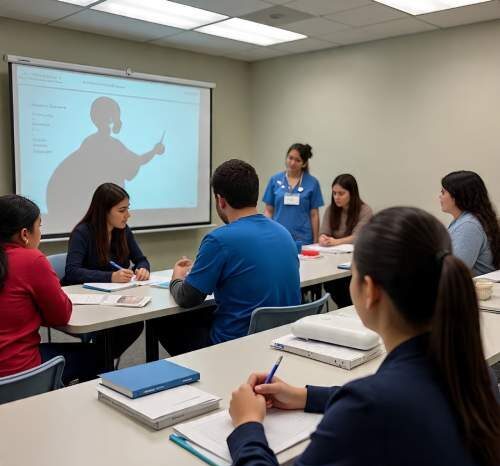Proven Steps: US States That Don’t Require CGFNS for Foreign Nurses (2025 Update)

In 2025, the number of US States That Don’t Require CGFNS for Foreign Nurses has remained relatively stable, but the pressure of nationwide nursing shortages is prompting more boards of nursing to reconsider their requirements. Some states are relaxing rules to attract more qualified nurses from abroad, while others are maintaining their CGFNS requirement to ensure consistency in standards. This means that up-to-date, state-specific research is essential before you apply.

For foreign nurses, understanding is more than just a licensing technicality, it’s a strategic career decision. In a profession where every month of delay can mean lost income and missed opportunities, choosing a state with streamlined requirements can make a dramatic difference. These states recognize that competent nurses can be evaluated through the NCLEX exam and credential reviews without the additional CGFNS exam, which can take months to complete and often requires extra fees.
This doesn’t mean that these states have lower standards for nursing practice. Instead, they use alternative methods to evaluate your nursing education and skills, such as direct transcript evaluation, primary source verification, or proof of active licensure in another U.S. state. For many foreign-trained nurses—especially those coming from countries with similar nursing curricula and English-based instruction—this can speed up the process while still ensuring safe and high-quality care for patients.
Another critical point to remember is that “not requiring CGFNS” doesn’t mean “no paperwork.” You’ll still need to provide proof of your nursing education, official transcripts sent directly from your school, English proficiency test scores (such as IELTS or TOEFL, if applicable), and a successful NCLEX result. In some cases, you might also need to demonstrate recent nursing experience to qualify for licensure without CGFNS.
The advantages of targeting U.S. States That Don’t Require CGFNS for Foreign Nurses are clear:
-
Faster application processing – Eliminating the CGFNS step can cut months off your timeline.
-
Lower costs – Avoiding CGFNS exam and document processing fees can save hundreds of dollars.
-
Earlier workforce entry – You can start working sooner, which is especially valuable if you already have a U.S. job offer.
However, there’s also a potential drawback—your license may be harder to endorse into states that do require CGFNS. If you plan to move between states in the future, you’ll want to factor that into your decision.

This 2025 update will guide you through each state’s stance on CGFNS, offering verified, current information sourced directly from state boards of nursing and reputable regulatory bodies. With this knowledge, you can confidently choose where to begin your U.S. nursing journey—saving time, reducing stress, and positioning yourself for career success in America.
How We Can Confirm State Requirements
-
Visit individual state Boards of Nursing websites. Check their licensure sections for “Internationally Educated Nurses,” “CGFNS,” or “Credential Evaluation” to see if CGFNS is required.
-
Consult resources like NurseLicensing.org or NCLEX preparatory services, which often track licensure variations by state.
-
Search trusted nursing forums or publications, where cohorts of foreign-educated nurses discuss their experiences and share tips.
Below is a starter framework—a list of states often mentioned in practice and anecdotal evidence as less likely to require CGFNS, based on recent discussions and candidate testimonials. Please note: this is a preliminary guide and should be verified directly via official state resources.
States Commonly Not Requiring CGFNS (To Be Verified)
| State | Notes & Suggested Confirmation Actions |
|---|---|
| California | Often accepts NCLEX + direct transcript evaluation. Verify under “International Applicants – RN/PN” on CA Board of Nursing website. |
| Texas | Typically uses independent academic evaluation services (like CGFNS alternatives). Check the Texas Board of Nursing for updated 2025 rules. |
| Florida | May accept primary-source verified transcripts and NCLEX without CGFNS. Validation needed via Florida Board’s “Foreign‐Educated Nurse” section. |
| New York | NY has more stringent requirements but may waive CGFNS if certain credentialing is complete—requires careful confirmation. |
| Massachusetts | Sometimes leverages direct transcript review over CGFNS. Verify latest evidence on the Massachusetts Board of Registration in Nursing site. |
| Illinois | Typically accepts equivalent credential evaluations. Confirm via “Licensure – IEN” subpages. |
Next Steps for Verification
-
Go directly to each state’s Board of Nursing website, for example:
-
“California Board of Registered Nursing international nurse requirements”
-
“Florida Board of Nursing foreign-educated applicants”
-
-
Locate sections labeled International Nurse or CGFNS requirement, and check FAQ or “Licensure Requirements” pages.
-
Document whether CGFNS is required, or if alternatives are accepted, including acceptable evaluator services and evidence needed.
Why Direct Research Matters
-
State policies change—some boards have been adapting requirements due to nurse staffing shortages.
-
Terminology varies—some use terms like “credential evaluation,” “primary source verification,” or “foreign-educated nurse application” instead of explicitly naming CGFNS.
-
Some states may partially waive CGFNS, contingent on factors like your country of education, proof of competency, or exam performance.
State-by-state: where CGFNS is typically not strictly required (and how to verify)

California
Typical stance: California Board of Registered Nursing (BRN) generally accepts foreign-educated nurses who complete required transcript evaluation and pass the NCLEX-RN/PN without mandating CGFNS specifically. California uses its own application and primary-source verification processes.
What to do: Apply through the CA BRN “International Nurse” page, request official transcripts sent directly from your school, and follow BRN guidance for credential evaluation. Confirm whether CGFNS or an alternate evaluator is expressly required for your country of education.
Texas
Typical stance: Texas Board of Nursing commonly accepts NCLEX plus a credential evaluation from an approved evaluation service. Some applicants use CGFNS but Texas also accepts other recognized evaluation services or primary-source transcript verification.
What to do: Check the Texas BON “Internationally Educated Nurses” instructions for the list of accepted evaluation/verification services and any English proficiency rules.
Florida
Typical stance: Florida often allows foreign-educated nurses to be licensed by submitting verified transcripts and passing the NCLEX. CGFNS is not universally required; instead the Board requires primary-source verification and transcript evaluation.
What to do: Visit the Florida Board of Nursing foreign-educated section; verify whether they require specific evaluators or simply primary-source verification and NCLEX eligibility.
New York
Typical stance: New York has historically been one of the stricter states. It typically requires thorough credential reviews and may specify credentialing standards that many international applicants meet through CGFNS — but CGFNS is not automatically required for every applicant if other approved credential evaluation routes are available.
What to do: Read NYSED / Office of the Professions guidance carefully. If your education is from a country with recognized equivalency, NYSED may accept alternative evaluations—verify exact 2025 wording on their site.
Illinois
Typical stance: Illinois Board of Nursing often accepts credential evaluations other than CGFNS and focuses on primary source verification plus NCLEX. CGFNS is commonly used by applicants but is not always a universal requirement.
What to do: Confirm on the Illinois BON “Foreign-Educated” page which evaluation services and supporting documents they accept.
Massachusetts
Typical stance: Massachusetts typically allows NCLEX + verified transcripts and may accept alternate credentialing services. Like other states it looks for primary-source verification and evidence of education equivalent to U.S. programs.
What to do: Check the Massachusetts Board of Registration in Nursing instructions for internationally educated nurses to see current evaluation preferences.
Practical verification steps (do these for any state)
-
Open the state Board of Nursing website and find the “Internationally Educated Nurses” / “Foreign-Educated Applicants” page.
-
Search that page for “CGFNS,” “credential evaluation,” “primary source verification,” and “NCLEX.” Those keywords reveal whether CGFNS is required or optional.
-
If wording is unclear, email or call the board’s licensure unit (most boards list a licensure contact email/phone) and ask: “Do you require CGFNS certification, or do you accept alternate credential evaluation/primary-source verification?” Save the reply for your files.
-
Confirm English proficiency rules (IELTS/TOEFL may still be required if instruction wasn’t in English).
-
If immigration or work visa is involved, check whether VisaScreen or CGFNS is required by the employer/visa category — this is separate from state licensure.
Ultimate Guide: Cheap Way for Kenyan Nurse to Get US License 2025
U.S. States That Don’t Require CGFNS for Foreign Nurses (State-by-State Action Guide 2025 Update)

California — Quick facts & what to prepare
Usual approach: California typically evaluates foreign-educated nurses via its BRN process; many applicants proceed with NCLEX eligibility and primary-source transcript verification rather than a mandatory CGFNS certificate.
Documents to prepare
-
Official transcripts (sent directly by school to CA BRN)
-
Course-by-course syllabus (if requested)
-
Verification of licensure from home country (primary source)
-
English proficiency evidence (IELTS/TOEFL) if training was not in English
-
NCLEX registration & application
Practical tip: Request school transcripts early — CA BRN can take several weeks to verify foreign transcripts.
Texas — Quick facts & what to prepare
Usual approach: Texas accepts NCLEX plus credential evaluation/primary-source verification. CGFNS is commonly used but not the only accepted evaluator.
Documents to prepare
-
Official transcripts (primary-source)
-
Credential evaluation from an approved evaluator (if required)
-
Licensure verification from country of origin
-
English proficiency scores (as applicable)
Practical tip: Check accepted evaluation providers in advance; some boards list a roster of accepted evaluators.
Florida — Quick facts & what to prepare
Usual approach: Florida often licenses foreign-educated nurses by verified transcripts + NCLEX without universally mandating CGFNS.
Documents to prepare
-
Official transcripts and program details
-
Verified licensure documentation
-
NCLEX registration
-
English proficiency (if applicable)
Practical tip: Florida processes can vary by country of training—document translation and notarization are common requirements.
New York — Quick facts & what to prepare
Usual approach: New York is more exacting historically; CGFNS is commonly used by applicants, but NY may accept other equivalency routes in some cases.
Documents to prepare
-
Comprehensive transcripts and detailed course descriptions
-
Primary source licensure verification
-
Evidence of English competency (often required)
-
NCLEX application
Practical tip: If your country’s curriculum closely matches U.S. standards, prepare a comparative program summary to speed review.
Illinois — Quick facts & what to prepare
Usual approach: Illinois typically focuses on primary-source verification, transcript review, and NCLEX — CGFNS often optional.
Documents to prepare
-
Transcripts sent directly
-
Verification of previous licensure
-
Proof of clinical hours (if requested)
Practical tip: Keep scanned copies of all documents and the dates you sent them for follow-up.
Massachusetts — Quick facts & what to prepare
Usual approach: Massachusetts generally accepts evidence of education equivalency and NCLEX without explicitly requiring CGFNS in every case.
Documents to prepare
-
Official transcripts and program info
-
Licensure verification
-
English language proof if needed
-
NCLEX paperwork
Practical tip: Translate and notarize non-English documents before submitting if the board requests originals.
Official State Boards of Nursing (Government Sources)
These are the most credible and current places to confirm state-specific licensing rules.
-
California Board of Registered Nursing (BRN) – International Applicants
https://www.rn.ca.gov/applicants/intl.shtml -
Texas Board of Nursing – Internationally Educated Nurses
https://www.bon.texas.gov/licensure_ien.html -
Florida Board of Nursing – Foreign Educated Nurses
https://floridasnursing.gov/licensing/registered-nurse-registered-nurse-by-examination-foreign-educated/ -
New York State Education Department – Office of the Professions (Nursing)
http://www.op.nysed.gov/prof/nurse/nurseforms.htm -
Illinois Department of Financial & Professional Regulation – Nursing Licensure
https://idfpr.illinois.gov/profs/nursing.html -
Massachusetts Board of Registration in Nursing – Licensure
https://www.mass.gov/nursing-licensure
2. Credentialing & Exam Authorities
-
CGFNS International – Official Website
https://www.cgfns.org -
NCLEX (National Council of State Boards of Nursing – NCSBN)
https://www.ncsbn.org/nclex.htm -
VisaScreen® Certification Program (CGFNS) – for immigration requirements
https://www.cgfns.org/services/visascreen/
3. Additional Trusted Nursing & Regulatory References
-
National Council of State Boards of Nursing (NCSBN) – State Board Contacts
https://www.ncsbn.org/contact-bon.htm -
U.S. Department of Labor – Occupational Outlook for Registered Nurses
https://www.bls.gov/ooh/healthcare/registered-nurses.htm -
American Nurses Association (ANA) – Professional standards & advocacy
https://www.nursingworld.org/


